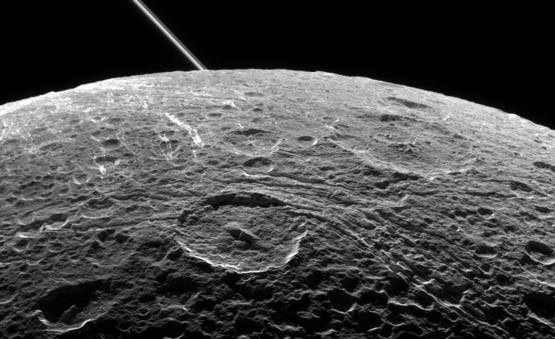NASA's Cassini spacecraft paid a visit to Saturn's moon Dione this week, one final time.
Cassini passed just 474 kilometers (295 miles) above the surface of the icy moon on Monday, August 17
th
at 2:33 PM EDT/18:33 UT. The flyby is the fifth and
final pass of Cassini
near Dione (pronounced dahy-OH-nee). The closest passage was 100 kilometers (60 miles) in December 2011. This final flyby of Dione will give researchers a chance to probe the tiny world's internal structure, as Cassini flies through the gravitational influence of the moon. Cassini has only gathered gravity science data on a handful of Saturn's 62 known moons.
"Dione has been an enigma, giving hints of active geologic processes, including a transient atmosphere and evidence of ice volcanoes. But we've never found the smoking gun," said Cassini science team member Bonnie Buratti in a
recent press release
. "The fifth flyby of Dione will be the last chance."
[caption id="attachment_121942" align="alignnone" width="544"]
A map of Dione.
Click here
for a full large .pdf map. Credit: USGS[/caption]
Voyager 1 gave us our very first look at Dione in 1980, and Cassini has explored the moon in breathtaking detail since its first flyby in 2005. This final pass targeted Dione's north pole at a resolution of only a few meters. Cassini's Infrared Spectrometer was also on the lookout for any thermal anomalies, a good sign that Dione may still be geologically active. The spacecraft's Cosmic Dust Analyzer also carried out a search for any dust particles coming from Dione. The results of these experiments are forthcoming. In a synchronous rotation, Dione famously displays a brighter leading hemisphere, which has been pelted with E Ring deposits.
[caption id="attachment_121943" align="alignnone" width="580"]
Dione (center) with Enceladus(smaller and to the upper right) in the distance. Image credit: NASA/JPL-Caltech/Space Science Institute[/caption]
The raw images from this week's flyby are now available on the NASA Cassini website. You can see the sequence of the approach, complete with a 'photobomb' of Saturn's moon Enceladus early on. Dione then makes a majestic pass in front of Saturn's rings and across the ochre disk of the planet itself, before snapping into dramatic focus. Here we see the enormous shattered
Evander impact basin
near the pole of Dione, along with Erulus crater with a prominent central peak right along the day/night terminator. Dione has obviously had a battered and troubled past, one that astro-geologists are still working out. Cassini then takes one last shot, giving humanity a fitting final look at Dione as a crescent receding off in the distance.
[caption id="attachment_121944" align="alignnone" width="500"]
Dione in profile against Saturn.
- Image credit
-
NASA/JPL-Caltech/Space Science Institute[/caption]
It'll be a long time before we visit Dione again.
"This will be our last chance to see Dione up close for many years to come," said Cassini mission deputy project scientist Scott Edgington. "Cassini has provided insights into this icy moon's mysteries, along with a rich data set and a host of new questions for scientists to ponder."
Cassini also took a distant look at Saturn's
tiny moon Hyrrokkin
(named after the Norse giantess who launched Baldur's funeral ship) earlier this month. Though not a photogenic pass, looking at the tinier moons of Saturn helps researchers better understand and characterize their orbits. Even after more than a decade at Saturn, there are tiny moons of Saturn that Cassini has yet to see up close.
[caption id="attachment_121945" align="alignnone" width="580"]
The limb of Dione on close approach.
- Image credit
-
NASA/JPL-Caltech/Space Science Institute[/caption]
Next up for Cassini is a pass 1,036 kilometers (644 miles) from the surface of Titan on September 28
th
, 2015.
Launched in 1997, Cassini has given us over a decade's worth of exploration of the Saturnian system, including the delivery of the European Space Agency's Huygens lander to the surface of Titan. The massive moon may be the target of a proposed mission that could one day sail the hazy atmosphere of Titan, complete with a nuclear plutonium powered MMRTG and
deployable robotic quadcopters
.
Cassini is set to depart the equatorial plane of Saturn late this year, for a series of maneuvers that will feature some dramatic passes through the rings before a final fiery reentry into the atmosphere of Saturn in 2017.
[caption id="attachment_121946" align="alignnone" width="580"]
A farewell look at Dione.
- Image credit
-
NASA/JPL-Caltech/Space Science Institute[/caption]
Astronomer Giovanni Cassini discovered
Dione
on March 21
st
, 1684 from the Paris observatory using one of his large aerial refracting telescopes. About 1,120 kilometers in diameter, Dione is 1.5% as massive as Earth's Moon. Dione orbits Saturn once every 2.7 days, and is in a 1:2 resonance with Enceladus, meaning Dione completes one orbit for every two orbits of Enceladus.
In a backyard telescope, Dione is easily apparent along with the
major moons of Saturn
as a +10.4 magnitude 'star.' Saturn is currently a fine telescopic target in the evening low to the south on the Libra-Scorpius border, offering prime time observers a chance to check out the ringed planet and its moons. Fare thee well, Dione… for now.
 Universe Today
Universe Today
